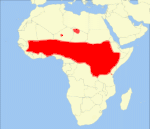 Olive
Baboon Olive
BaboonPapio anubis (aka
Anubis Baboon)
Description
This baboon's common name
refers to its dark olive-gray fur color. The dark
gray face is devoid of fur, as is the rump. A
fully-grown adult male has a mane that runs from
the top of its head through the shoulders.
Adult males average 2.5 feet in
length, plus a tail of about 1.75 feet, and weigh
about 55 pounds. Females are noticeably smaller,
with a body length of 2 feet, tail length of 1,5
feet, and weight of 30 pounds. Males also have
large canine teeth.
 Distribution and Habitat Distribution and Habitat
The olive baboon ranges across
most of central sub-Saharan Africa, and there are
isolated populations within the Saharan region.
It lives in a variety of habitats, with savannah,
grassland steppe, and rainforest being the most
common.
Diet
Like all baboons, the olive
baboon is an omnivore, with a diet that includes fruits,
tree gums, insects, eggs, seeds, flowers, grass,
rhizomes, corms, roots, tubers, and small
vertebrates. It has also become a pest in many
areas by raiding agricultural crops.
Reproduction
Males compete for access to females in heat,
but the female has the final say in which male
(or males) she mates with. While higher-ranking
males tend to have easier access to females,
subordinate males often gain a mating advantage
by forming friendships with females. In these
friendships, males groom, share food, and have
strong affiliative ties with particular females
and their offspring. Females tend to exhibit a
preference for mating with their male friends.
A single offspring is born after a gestation
period of about 180 days. The infant is
completely dependent on its mother for the first
month. At 4-6months it will start to spend most
of its time with other juveniles within the
troop, and will be fully weaned at about 14
months. Male olive baboons are known to carry,
protect, share food (especially meat), groom, and
play with, the offspring of their female friends,
but whether they do so as "fathers" or
to keep the friendships strong is unknown. Males
typically leave their natal troop upon reaching
puberty, at 4-6 years.
Other Habits and
Behaviors
Olve baboons spend most of their time on the
ground, retreating to the trees primarily for
sleeping.
Like other baboons, the olive is a highly
social animal. An average troop may be comprised
of 20-50 animals, but troops of up to 100
individuals are possible is areas with plenty of
highly nutritional foods. Within each troop there
is a dominance hierarchy among females that tends
to be very stable over time. In general, an
individual female occupies a place in the
dominance hierarchy immediately below her mother
and her younger sisters, moving up only upon the
death of the mother. Male dominance hierarchies
tend to be more flexible, as new males enter and
out-compete older males.
Scientific
Classification
phylum Chordata
subphylum Vertebrata
class
Mammalia
order
Primate
family Cercopithecidae
genus & species Papio anubis

Animal Diversity Web http://animaldiversity.org/accounts/Papio_anubis/
Questions or comments about
this page?
|



